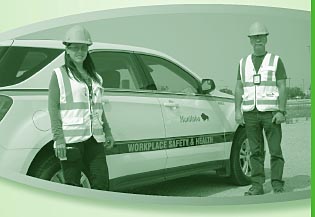FAQs: Harmonization of Occupational Safety and Health Enforcement Amendments
When are the amendments in effect?
Amendments took effect November 23, 2018.
Standards
Where can I purchase the standards with the new updates?
Standards can be viewed for free online after a quick simple registration on the CSA Communities website.
Once logged in, use the direct link to the standards.
Alternatively, standards can be purchased from the Canadian Standards Association Store.
First Aid Training
- What standard has to be met?
Workers must meet the training curriculum set out in the Canadian Standards Association (CSA), CSA Z1210 - First Aid training for the workplace - Curriculum and quality management for training agencies. Workers will be required to be trained to the applicable workplace first aid training level.
Basic formerly recognized as First Aider 1 (FA1)
Intermediate formerly recognized as First Aider 2 (FA2)
Advanced formerly recognized as First Aider 3 (FA3)
- I received my certification this past summer. Will I have to take the course again?
No, all certificates will be recognized as valid to the date of expiry.
- Why is it being changed?
By harmonizing to the standard, workplace first aid will be a part of a national system in reducing barriers to trade and labour mobility.
First Aid Kits
Do we have to purchase new kits immediately?
No, a transition time of one year will allow employers and suppliers time to use current supplies and either purchase new kits or stock supplies to the new standard. First aid kits are required to be in accordance with the Canadian Standards Association, CSA Z1220 - First aid kits for the workplace.
High Visibility Apparel
The Regulations refer to a new High Visibility Safety Apparel standard. Do we need to replace our current High Visibility Apparel?
The new standard CSA Z96.1, Guideline on Selection, Use and Care of High Visibility Safety Apparel, aides employers in selecting the appropriate apparel. There should be very minimal change to your high visibility apparel as the contents are consistent with today's expectation on selecting appropriate high visibility apparel.
Respiratory
- Will Compressed breathing air be required for different processes?
No, but in all circumstances that an employer provides compressed breathing air to a worker for any process, as established by the risk assessment and Safe Work Procedure conducted by the employer, the air must meet the purity of the Z 180.1-13 standard. Pure compressed breathing air is not only required if the air is being used in immediately dangerous situations, it is required whenever compressed breathing air is being used by a worker for any workplace process.
- Is it an additional requirement to provide an auxiliary air supply for immediately dangerous atmospheres?
The provision of an auxiliary line when using an airline equipped with a full face-piece, in immediately dangerous atmospheres, has always been a requirement. The amended provision only specifies that the auxiliary system must be worn or within arms reach. They are provided to allow for escape in the event that there is a problem with the line.
Floatation Devices
- Will we have to purchase new life jackets or personal floatation devices (PFD)?
No, the regulation is expanding its nationally recognized approval agencies. Currently Manitoba requires life jackets and PFDs to meet the Canadian General Standard Board (CGSB) which ultimately refers to the Transport Canada approval number. The amendment will now allow life jackets and PFDs approved by Fisheries and Oceans Canada and the Canadian Coast Guard.
- When is a worker required to wear life jackets or PFDs?
When a worker is required to work at a place in which the worker could drown except when
(i) there are other sufficient measures in place to protect a worker from the risk of drowning, such as a guardrail or fall protection system meeting the requirements of Part 14
(ii) the personal flotation device or life jacket would be ineffective, or unreasonable.
Hearing Protection
- Will this change from annual hearing tests to every two years diminish worker safety in terms of hearing conservation?
A shift in hearing is a chronic condition, it occurs over time. Hearing shifts do not differ significantly from one year to another. The employer still has the responsibility to conduct hearing test results, conduct a noise survey that measures the noise levels workers are exposed to, ensure workers are provided with hearing protectors appropriate for their noise levels and that they know how to use them (i.e. insert them) and ensure the workers wear them. The COMO has the power to mandate additional medical monitoring if and where required.
- Will the change in collecting a baseline hearing tests diminish the worker safety in terms of hearing conservation?
The collection of baseline hearing tests is in accordance with the CSA standard Z94.2-14. Since a shift in hearing is a chronic condition. The change from 70 to 180 days for obtaining a baseline hearing test should not make any noticeable difference in a hearing test result.
- Will we need new hearing protection or have to conduct new surveys?
No. The updated CSA standard Z 94.2-14 just makes it easier to choose the appropriate hearing protection. The calculation to adjust the noise reduction rating is more clear. Worker training for use of hearing protection was always required.

Contact the Workplace Safety & Health Branch
Phone: 204-957-SAFE (7233)
Toll-free: 1-855-957-SAFE (7233)
www.manitoba.ca/labour/safety/

